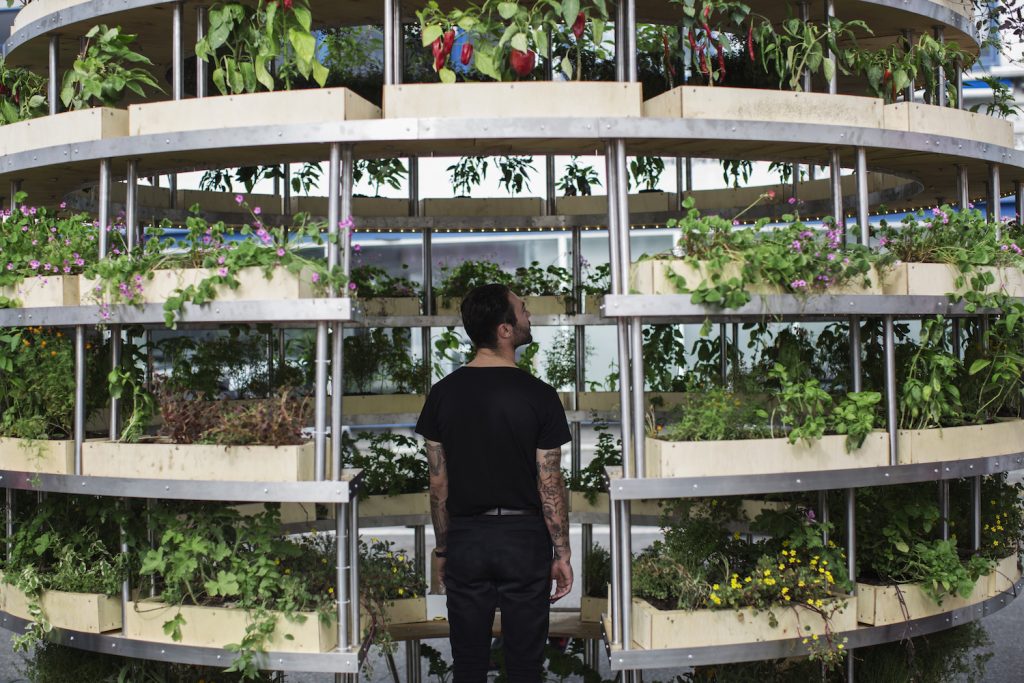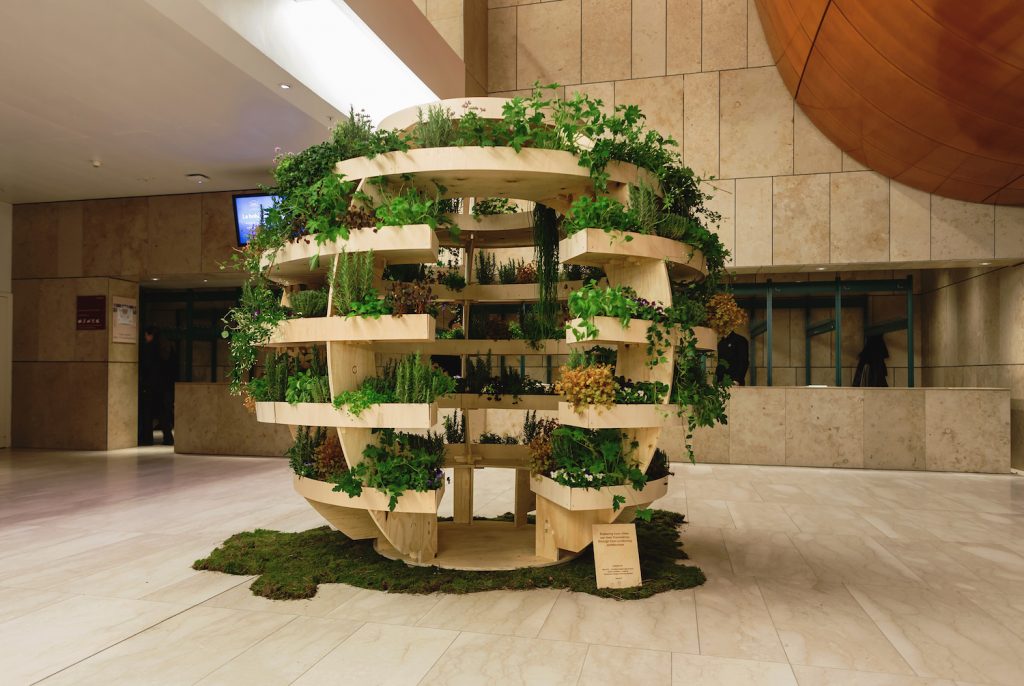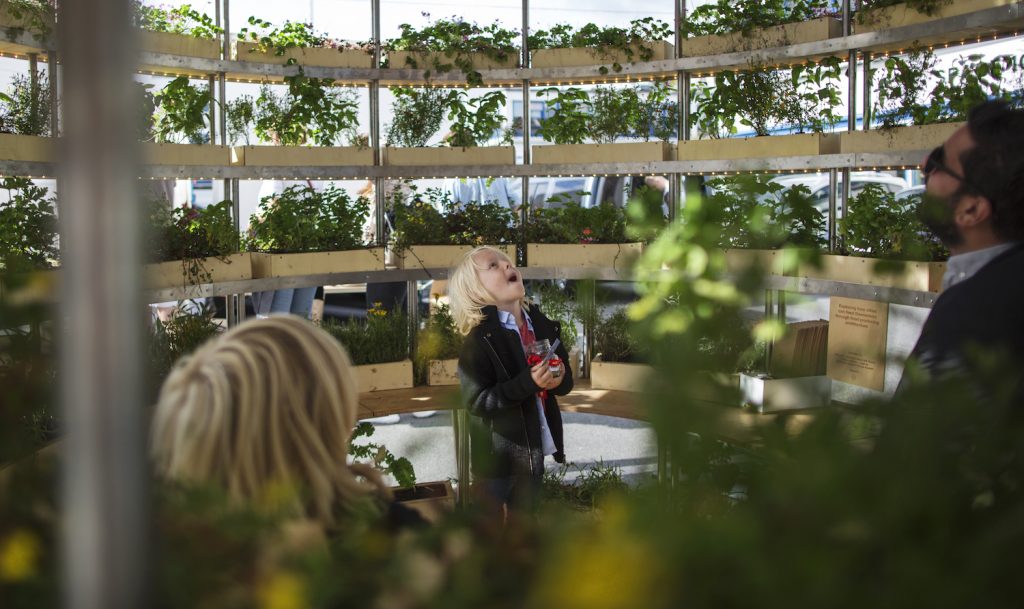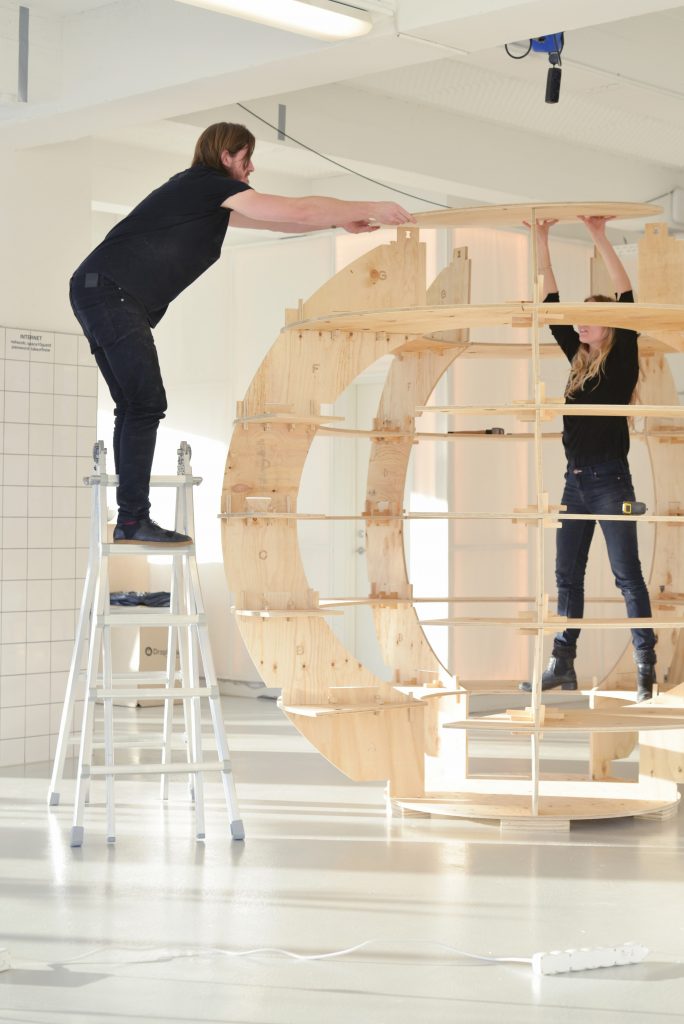Help us protect the commons. Make a tax deductible gift to fund our work. Donate today!

Photo by Alona Vibe, Munchies Festival
SPACE10 is a Danish “future living lab” with an open source twist. Founded by IKEA in 2015, the lab is focused on innovative design to help solve some of the world’s biggest problems. To that end, in February 2017, the lab licensed their popular Growroom design under CC BY in order to provide the maximum impact possible. This attractive, sustainable indoor circular garden quickly grows a massive amount of food in only a few square feet by utilizing vertical space, urban architecture, and hydroponics. In the words of director Carla Cammilla Hjort, “At Space10, we envision a future where we grow much more food inside our cities. Food producing architecture could enable us to do so.”
The Growroom can be downloaded and fabricated for free at the SPACE10 website and you can find out more about the project via their “Conversational Form.” Thanks to SPACE10 Communications Director Simon Caspersen for the interview.

Photo by Alona Vibe
The Growroom was launched in 2016 and open-sourced in February 2017. The expressed impetus for open sourcing the design was to encourage local production and materials. How did you come to that conclusion, and how has the project changed since it was open sourced? Why is open sourcing the plans vital to local food production?
We feel it makes complete sense because both our global food production system and our global supply chain of goods are based on the same model.
We produce everything on massive scale far away from where we live and ship everything halfway across the planet and into our cities, where we consume it before we export the waste.
This model has served us well. Humans have never been more food secure in the history of mankind and it would probably not by overreaching to claim that much of the living standards and material prosperity of modern society can be traced back to our current industrial model. The model, however, also has its physical limits, and these have been reached.
Our food system is driven by scale, chemicals, and fuel. It is one of the most crucial drivers of climate change. It is a critical user of our dwindling supplies of fresh water, the process compromises the nutritional value of our food severely, and 1/3 of the food produced goes to waste due to spoilage and overproduction. Furthermore, we each year note the date when humanity exhausts a year’s supply of the earth’s natural resources. In 2006 that date fell in October. In 2016 it was in August. All the evidence suggests that if we continue at our current rate, we’ll soon need a second planet…
We wanted to explore alternatives. The Growroom started as an architecture competition that we launched together with CHART. We wanted to explore how cities can feed themselves through food producing architecture. The winner was two Danish architects: Sine Lindholm and Mads Ulrik Husum, who created The Growroom as a one-off pavilion for the festival. The ideas was to spark conversations about this local food production.
The Growroom ended up sparking excitement from Taipei to Helsinki, from Rio de Janeiro to San Francisco, where people reached out and wanted to buy or exhibit The Growroom. But we didn’t feel it made sense to promote local food production and then start a centralised production of The Growroom and ship this large structure across oceans and continents.
We therefore tapped into the fab city movements idea of globally connected, locally productive cities that aspires to produce everything within our cities, went back to the drawing board and remade a version designed for open source, so we could ship the digital design files and let people build it themselves locally instead of the physical structure.
SPACE10 is a lab, a journal, and an exhibition space that explores the future of urban development. How do you think that open source plays into the future of global cities and production? How do you balance your approach to open as an Ikea project?
I think open source is one of the most exciting opportunities of our time. Open source could potentially change everything and empower people in ways we can’t even imagine. One thing is that open source and the advancements in digital fabrication will allow us to make everything locally – on demand. Whether it’s furniture, housing, cities, everything. Open source also enable us to not only share but also learn, build upon, and develop together. I deeply believe that if you are the smartest person in a room, you are in the wrong room. We need to surround ourselves with people who are smarter than us and open source allow us to learn and work together with the brightest minds out there.
In terms of IKEA, we are 100 % supported by IKEA and we work as an external future-living lab. If we weren’t looking into the opportunities of open source, we would be a pretty useless future-living lab, wouldn’t we?
We are also aware that transforming our current production system is a huge and complex issue and one of the biggest creative challenges of our time – and we also need to be aware of the social consequences if production moves out of areas where people depend on that for their livelihood. Nevertheless, it’s about getting in now, gaining learnings, and helping shape a future that is better for all of us.

Photo by Alona Vibe
How difficult is it to actually put together the Growroom? How long would it take? Have you seen any successful examples of the finished project that you’d like to share?
It is fairly simple actually. We have a very intuitive manual. No big tools needed: two rubber hammers and a screwdriver. We just exhibited in Milan for the design week and it took three people one hour, but they have also done it before and the local fab lab had a very precise CNC, so everything was like LEGO.
We are seeing different versions pop up different places using the hashtag: #space10growroom on instagram, but have also seen people who have set a little business up on top of the design – here is a nice little video from Denmark and a website in Belgium. There have also been articles in the USA and Canada. And we have been in touch with people who have concrete plans to build one in:
Lund, Sweden
Stockholm, Sweden
Helsinki, Finland
Rensselaer, United States
Minneapolis, United Sates
Pittsburgh, United States
Alberta, Canada
Québec, Canada
Germany
Plymouth, UK
Rio de Janeiro, Brazil
This is the real beauty of open source. Our version is just the beginning. People are iterating, improving it, personalizing it, scaling it and implement technology in it. We even talked with people who want to make it in mycelium and pressed dirt, so it becomes 100 % biodegradable.

Photo by Niklas Adrian Vindelev, SPACE10
What advice would you give to other architects and designers who want open source their designs? Do you have plans to openly license other designs at SPACE10 in the future?
If your aspiration in life is to design beautiful solutions that makes a difference for a lot of people, then you have a unique opportunity with open sourcing your solutions or build on top of others. We are challenged with some big questions and our current answers seems insufficient and outdated. We need collaboration and forward thinking people to work together more than ever. Open sourcing the physical world is still in early stage, so it’s about dipping your toes in the water, exploring the opportunities and seriously: how often do you have a chance to be a pioneer in a field that have the potential to change everything?
At SPACE10 we would like to open source every time it makes sense. We strongly believe that collaboration beats competition.
We launched an open source digital framework back in November called the “Conversational Form” that turns web forms into conversations — we make it easy for developers and designers to engage with users in a more compelling and conversational way. We needed one for ourselves, but couldn’t find any suitable solutions, so we decided to build one of our own and open sourced it. A couple of months after – 200.000 people use it on daily basis on different platforms, and developers from all over the world iterate and build upon our initial framework, which benefits everyone. Imagine how much money we would have needed to build that big of a team to do the same work inhouse. Or imagine if Wikipedia had decided to build their site with an inhouse team. Imagine how your architectural design could scale, develop and improve over time if you just open sourced it.
Why did you choose to use CC BY as your license?
I was actually a bit unsure of what the right license would be. I wanted it to be as accessible as possible, but it was important that Mads-Ulrik Husum and Signe Lindholm (the designers) were credited for their work.

Photo by: Alicia Sjöström, Salone Del Mobile
Design blogs are asking if the Growroom is the urban gardening of the future, cementing its importance in the development of cutting-edge urban agriculture. How are you maintaining the project’s longevity What hopes do you have for the Growroom, and what would you like to accomplish with it in the future?
We have been very overwhelmed and incredibly happy with the positive response we have had from people, design institutions and media. For us, the ideal outcome would be that we didn’t do anything, but that people are inspired to build it themselves locally and gets joy from producing food on their own doorstep, rooftop or in their community – that it brings people together, support people’s sense of well being and provides food that is fresh, healthy, organic, and tastes better. That is what we dream of and why we open sourced it in the first place. I would also love to see people improve it, make it better and be creative with the design.
Posted 13 April 2017